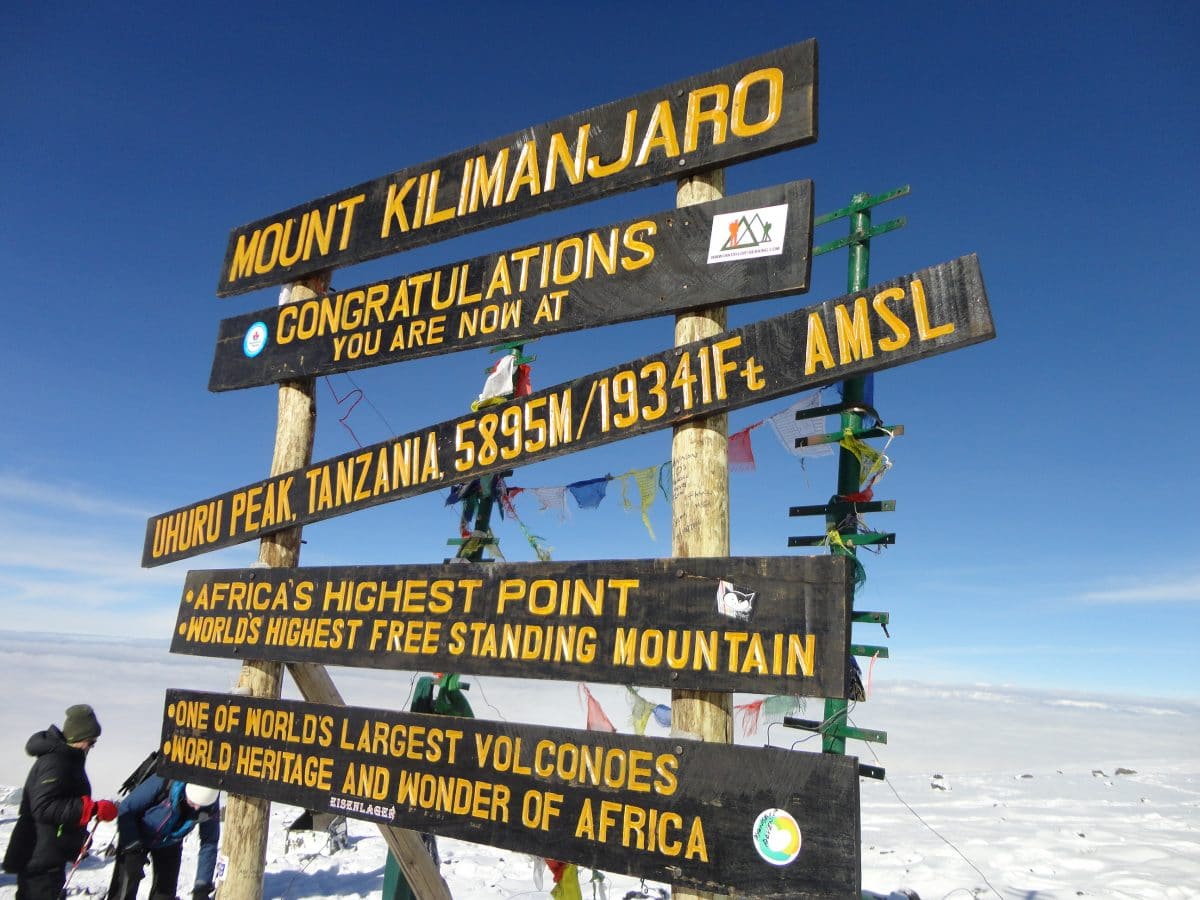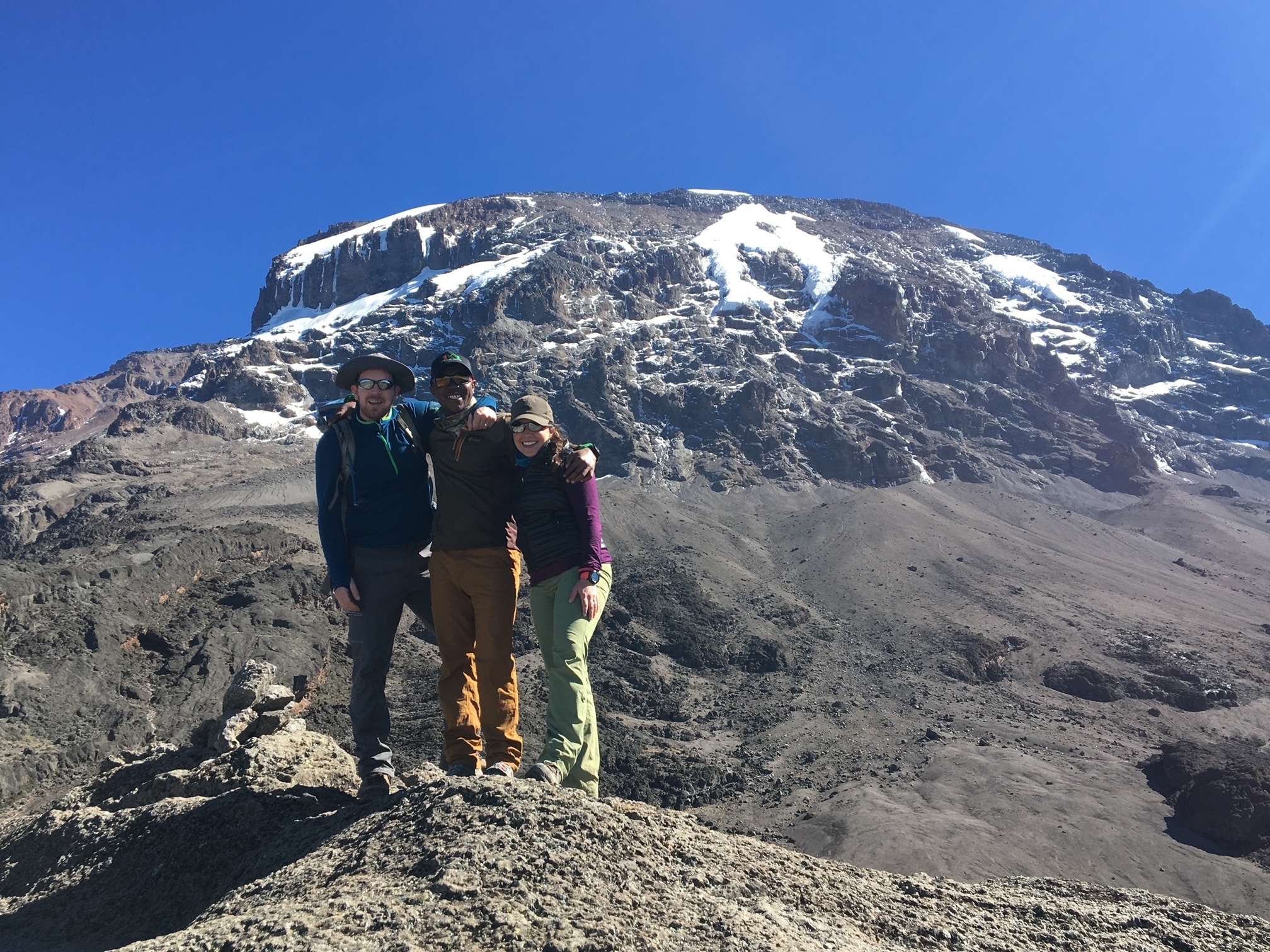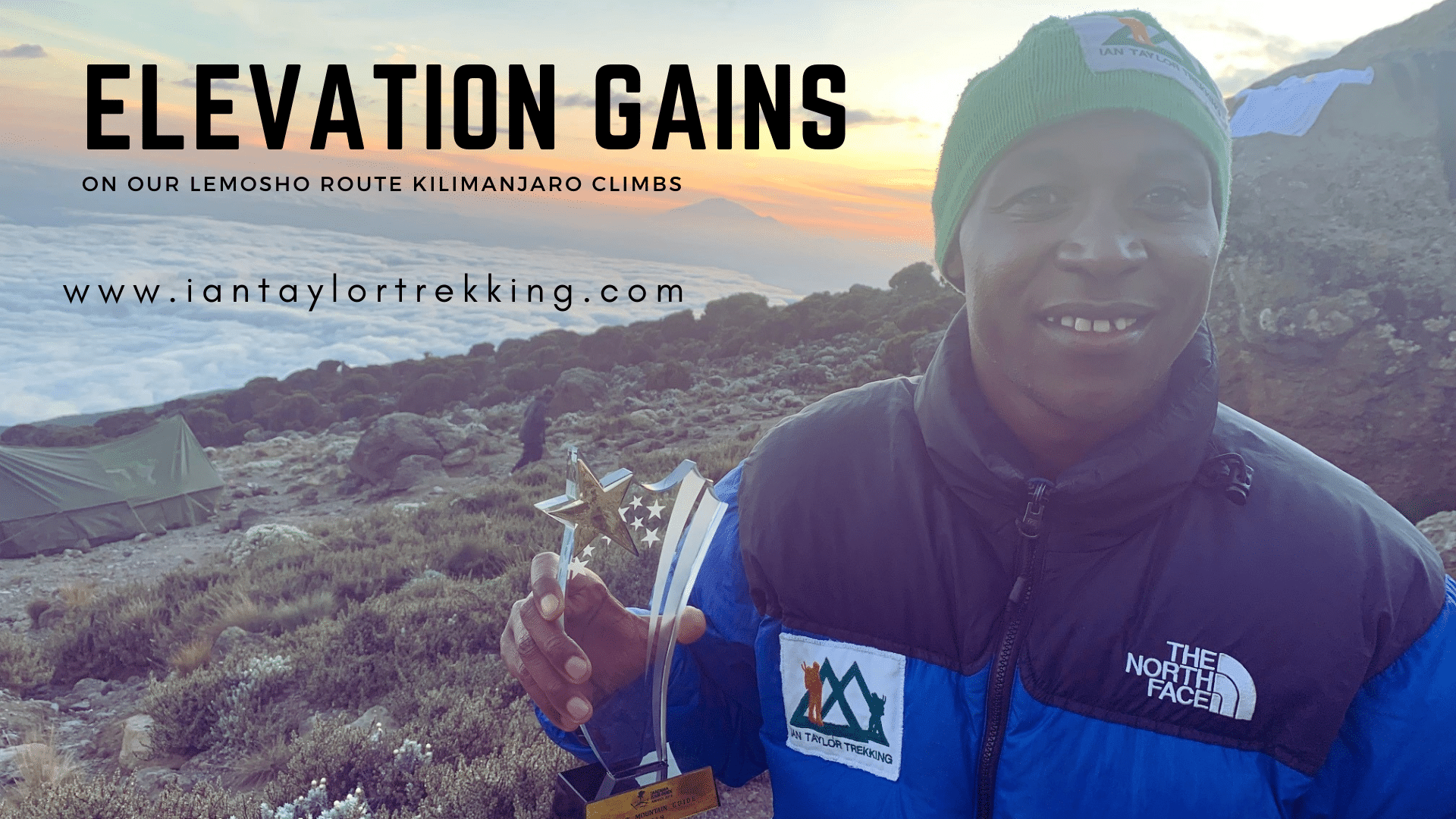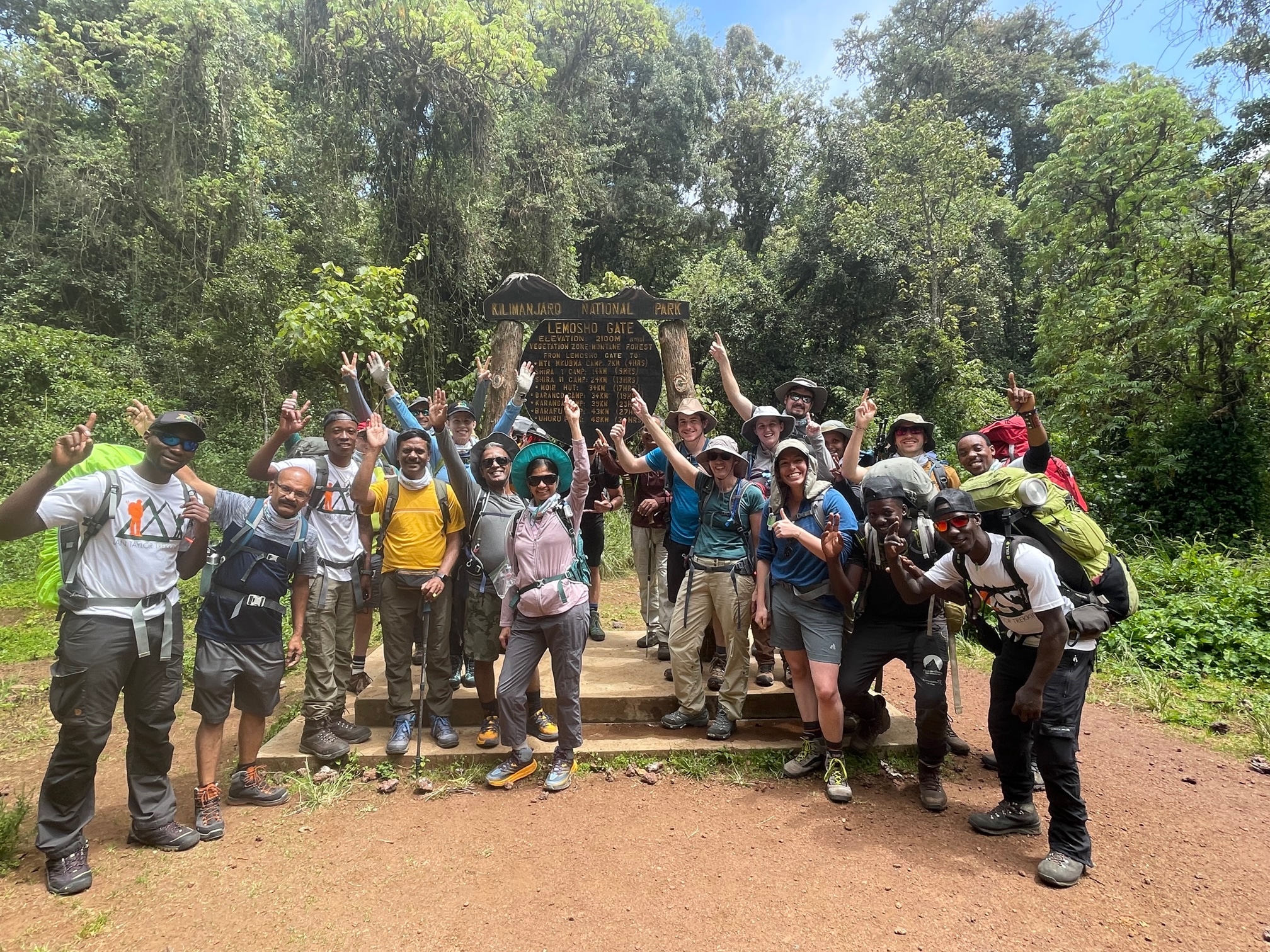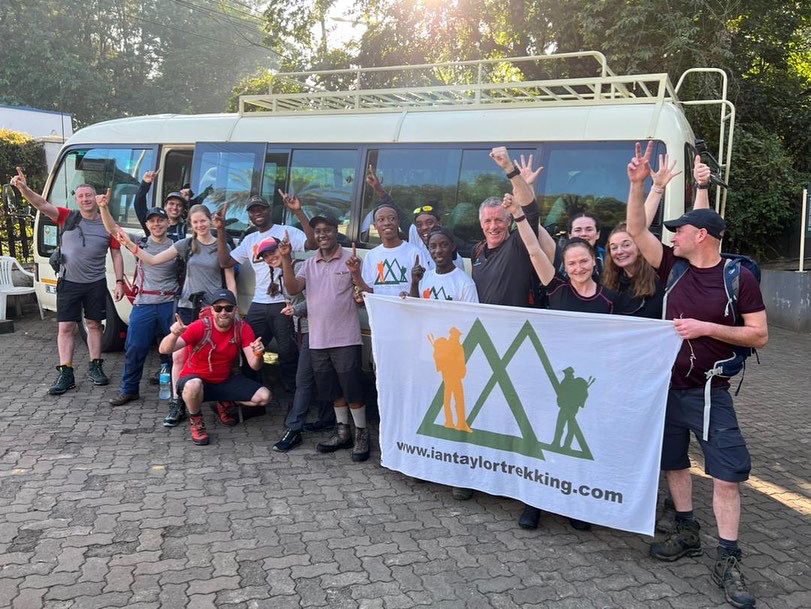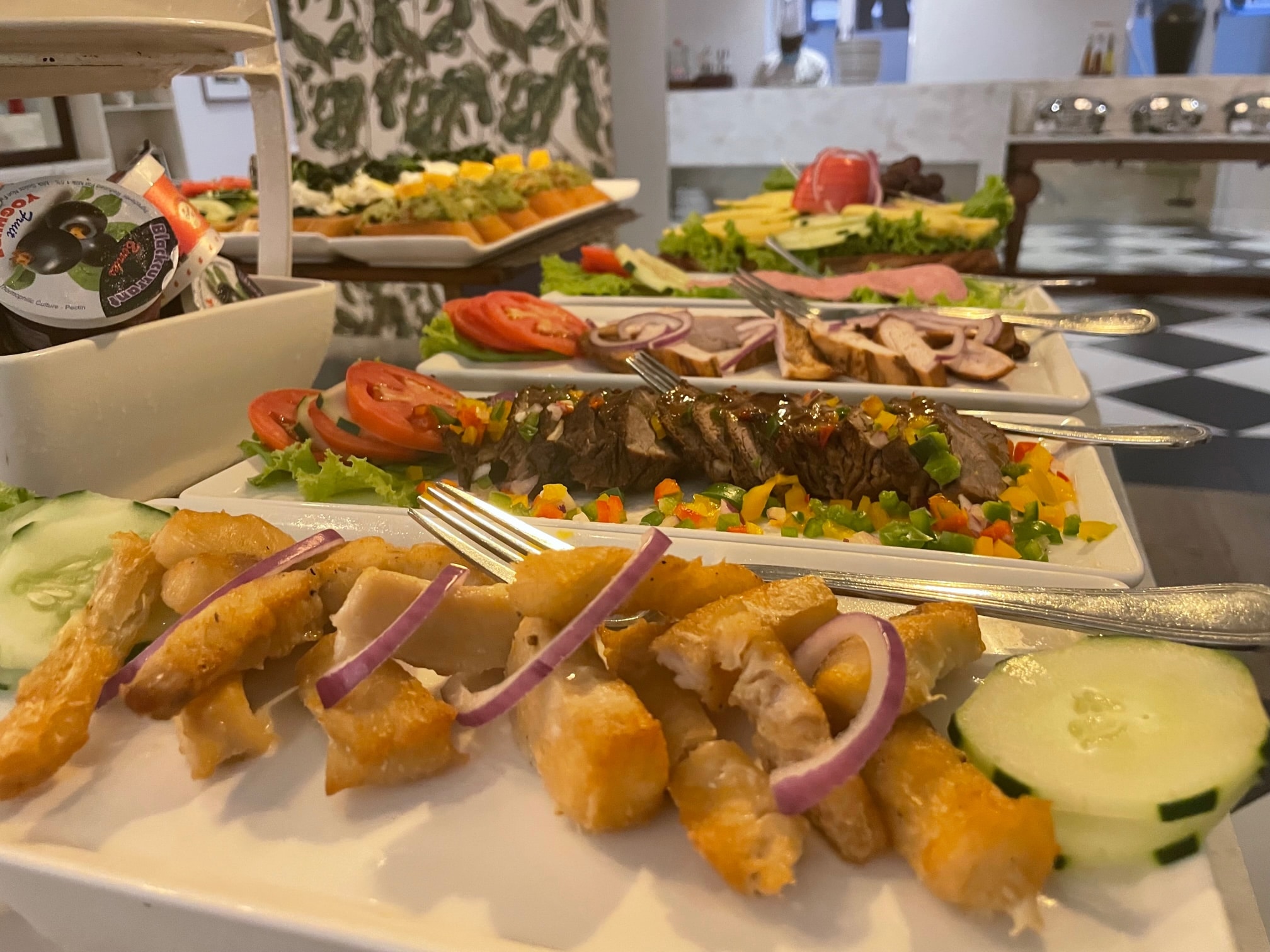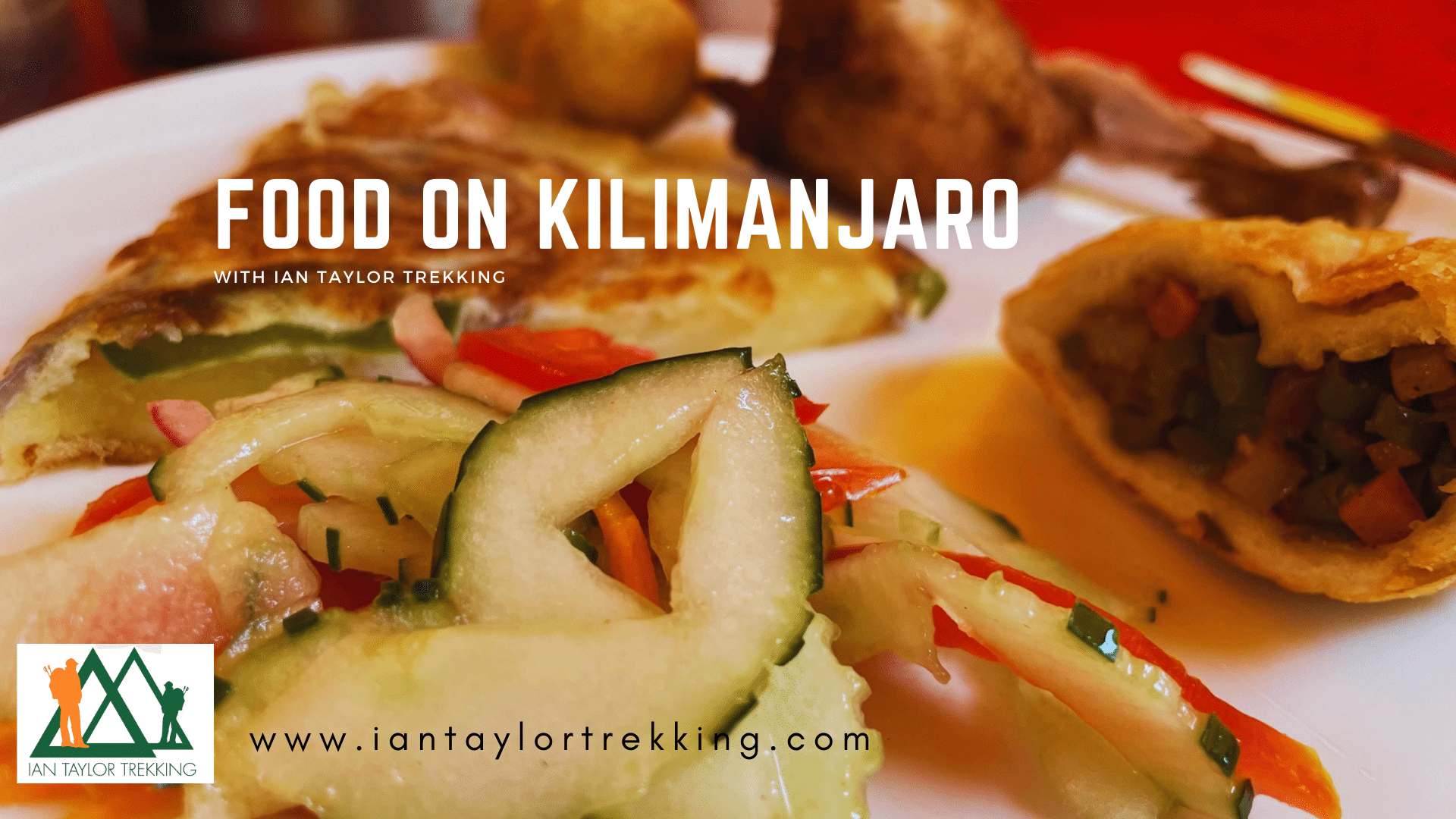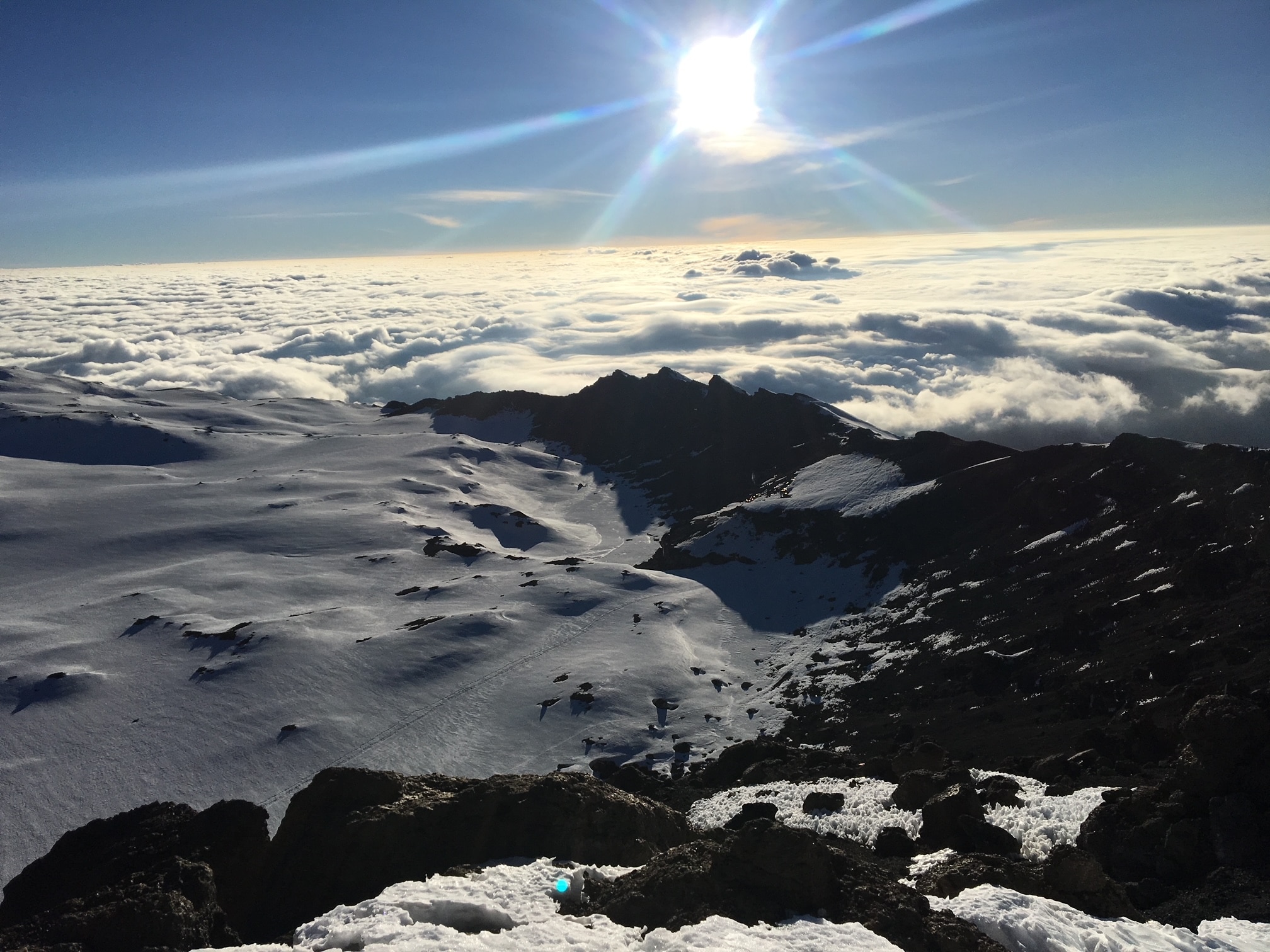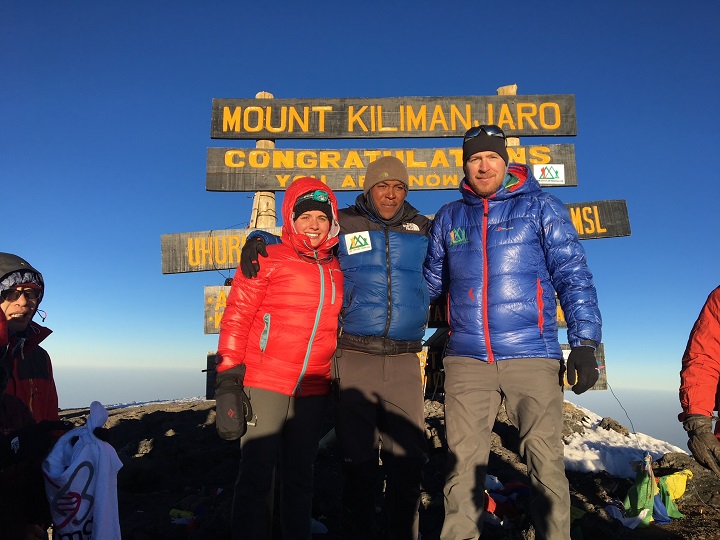After years of running trips on Kilimanjaro here are our our Top 50 Tips for Climbing Mount Kilimanjaro We have helped over 3,000 people reach the summit and have 95% success on our 8 day Lemosho Route trips. Ian has climbed Kilimanjaro 40+ times and our head guide on the mountain was voted Kilimanjaro’s Number 1 Guide in 2019.
Top 50 Tips for Climbing Mount Kilimanjaro
At Ian Taylor Trekking we run over 30 quality Kilimanjaro climbs each year. We are a world leader in offering the highest quality tours on Mount Kilimanjaro and happy to schedule a free personal assessment with you. CONTACT US. You can also check out all our schedules trip here and we can private private group trips for you.
Get Advice from the Experts
All our office staff have all climbed Kilimanjaro many times, so if you sign up to one of our trips you are getting the best available information about how to train and fully prepare for your adventure. Read some REVIEWS from our trips.
1). Choose the Best Route
For a wide range of reasons, we believe our Lemosho Route itinerary using Kosovo Camp 4,900m/ 16000 feet is the best route for your Kilimanjaro climb. You can also consider the Northern circuit route. We have designed our own unique itinerary for the best safety and success on the Lemosho route.
If you want to be safe, successful and have the best experience possible, that that is the route to choose. Likewise, we also feel the Lemosho Route is the most beautiful route and has less people in the initial part of the trip. There are officially seven routes on Kilimanjaro, however the majority of them just go straight up the mountain.
The Lemosho Route starts on the beautiful western slopes, encompasses the Shira Plateau, the stunning Barranco Valley all the way to the eastern side. We use Kosovo Camp above Barafu Camp for our summit attempt. Do yourself a favor, choose our unique itinerary on the Lemosho Route. Read some reviews from our clients.
2). Have the Best Acclimatization Possible
We recommend a minimum of 8 days on the mountain. More acclimatization means a safer climb, it’s as simple as that. Likewise, it means an easier ride for the porters and guides. Overall, you will enjoy your experience so much more on Kilimanjaro if you have enough time to acclimatize. One of the biggest problems on Kilimanjaro is people trying to go up the mountain way to quickly, not allowing themselves the necessary time to acclimatize to the low levels of oxygen. We never recommend step foot on Kilimanjaro with less than a seven day trek and 8 days is best.
At 5,895m/ 19,341 feet, Kilimanjaro’s summit is in the extreme level of altitude and not to be underestimated. The reason most people do not make the summit is that they choose a 5 or 6 day trip. Choosing a shorter trek on Kilimanjaro will definitely save you money, however what is that worth if you don’t make the summit. Yes, the trip in 8 days will be more expensive, however, there is no point going on the mountain if you don’t give yourself the best chance for success. Therefore, in our opinion, the only option is the 8 day trip up the Lemosho Route. Happy to chat with you if you would like further information on why acclimatization is critical for safety and success.
3). Train, Train, Train
This is a challenging question to answer. It will depend on your ability, experience, age, weight. All these factors need to be considered when you are thinking of climbing Kilimanjaro. Kilimanjaro is a peak that is accessible for most reasonably fit individuals, but you do have to physically prepare your body if you want to fully enjoy your adventure. I would recommend that you spend at least five days a week doing some sort of intense physical exercise for approximately six to eight months prior to your starting date of your climb.
We recommend that you spend at least four or five days a week, doing some sort of intense physical exercise. This should be done for approximately six to eight months prior to your start date of your trek. We recommend spending at least four days a week either walking up hill on a treadmill or on a stair-master (stair master is best) for one to two hours a day. You will also want to build up to carrying 10-12 kilos (22 – 25 lbs) in a backpack on your back.
Doing this type of daily training sessions, along with one longer day a week out in the hills, is ideal. In your longer session in the hills, you will want to walk from 4 – 7 hours, going up and down hills with the weighted pack on. I cannot stress enough how important this is to your training. CONTACT US and learn more about what we recommend.
4). Bring the Right Gear
Choosing the right gear and clothing is important. We have the most watched Kilimanjaro packing video on You Tube. If you sign up to one of our Kilimanjaro climbs we send out our 40 page document with an itemized kit list for climbing Kilimanjaro. There are many pieces of gear and clothing that are essential for our trip on Kilimanjaro, and I am not going to go through every piece of gear you need for the trip, I am just going to highlight some of the specific pieces that I found to be essential.
First of all, your feet are one of the most important parts of the body to take care of when trekking. Never skimp on footwear when you are going on a trip like Kilimanjaro. Buy a good, sturdy, waterproof pair of trekking boots and make sure that you break them in before you leave for Africa. Number two, buy yourself a good down jacket with with more down. Not a lightweight 800 fill down jacket. Remember that every brand and style is different and if you are questioning your down coat, make sure to ask our advice before the trip.
Number three, having both a water bladder (i.e, Camelbak brand) and two Nalgene style plastic bottles. Drinking water is essential on the mountain. Lower down, you will use the water bladder to get in enough water, however for the summit night this will freeze. So you will need the Nalgene bottles.
These three gear tips are obviously not the only gear you will need on the trip, however these are some of the essentials. Watch our Kilimanjaro packing video for further information. We are always available to help make sure our clients have the correct clothing.
5). Get the Trekking Boots Right
Having the right trekking boots for your Kilimanjaro climb could make or break your trip. Your boots need to be warm and well insulated with excellent ankle support. Check out some of boots we use and recommend. Different brands have designed and your foot shape might suit your foot type. We highly recommend trying on your boots in store and testing them in on a ramp and stairs in order to make sure they fit properly. Don’t forget to try them with your summit socks too! These boots will take some time to break in, therefore you want to make sure they fit correctly. Take some time to make sure they work for you. Try on a range of different brands until you are happy with the fit.
6). Use the Best Guides
Our Head Guide was voted Kilimanjaro’s Number 1 Guide. All our guides have gone through rigorous training and we have continual training available to them on the ground in the off season. Another one of our head guides has climbed Kilimanjaro over 500 times with 25 years experience working on Kilimanjaro. Our team is more of a family to us and they all know us personally.
7). Investing in the Local Community
Make sure you pick a team who have their own full time staff on the ground. All of our trips are based out of Arusha, Tanzania, and we have our own Ian Taylor Trekking staff on the ground in support of your climb. We invest in our staff, sending them to college and invest in them continually. We also have training available to staff that show they want more responsibility. Throughout the years, we have developed and trained guides who used to be porters. They have worked their way up to tent crew, kitchen staff, servers and now they have become our guides. Many of these guys have been working with us for over eight years now! We pay for their training and cover the college costs and in turn they work hard for us on every trip. We also support an orphanage in Arusha.
8). Learn From the Experts
You need access to professional Kilimanjaro Guides 5 days a week prior to your climb. If you are planning a mountaineering adventure like Kilimanjaro don’t go to a travel agent. Book the trip with mountain experts. All of our office staff have climbed Kilimanjaro over 9 times. Ian has climbed Kilimanjaro over 40+ times and is available daily in support of your climb. Make sure you are getting all the up to date information on how to plan and prepare correctly for your Kilimanjaro climb.
9). Have More Staff on the Mountain
A lot of companies cut corners. At times, you may see a group of 20 clients with two guides. We have seen groups of 10 clients with 1 guide. That is not how we want to run our trips! Your safety is our number one priority, so we think it is essential to have extra staff on the mountain with our teams. We have 4 to 6 kitchen crew, security team, more porters, guides and normally have 40 staff for a group of 10 trekkers.
10). Security on the Mountain
Unfortunately, there have been instances on Kilimanjaro where people are having things missing from their tents or luggage. We hear of groups being in their dinner tent or else on an acclimatization walk during the afternoon. They come back to their tent and find that someone had been in it, and taken items.
That does NOT happen on our Kilimanjaro trips! We have a security team on the mountain that are always watching over our teams when we are not in the tents. So when we are eating meals, on an acclimatization walk or going to the summit, you don’t have to worry about your valuables going missing!
11). Comfortable Tents
We use Mountain Hard Wear Trango 4 tents. These are 4 person tents that we only have 2 people sleeping in. They are warmer, more spacious and more comfortable. Remember you spend a lot of time in these tents.
Sleeping is a critical part of acclimatizing and having more space adds to your comfort level on the trip. We also use a Mountain Hard Wear Dome Tent with comfortable camping seats and the best food available.
12). Having a Professional Chef
Preparing high quality food is challenging under normal circumstances, however our chef and assistant chefs are preparing quality food on the side of the mountain. We serve you with three, three course hot meals each day on the mountain.
Our food and food menu is specifically designed to match the needs of each day climbing Kilimanjaro. We can also cater to your dietary restrictions. Check out our food menu for your Kilimanjaro climbs and feel free to get in touch for further information.
13). Mental Preparation for the Climb
Mentally prepare for the journey ahead! Depending on your level of comfort with the outdoors, you may need to prepare yourself for life on the mountain. Hopefully if you are signing up to a trip like this, you are a lover of the outdoors and very comfortable with the mountain living! The trip will include camping, bugs, dirt, baby wipe showers, and going to the toilet outdoors! If you are not used to rugged conditions, you will want to prepare yourself for what is to come.
14). Do Some Camping Prior to the Trip
Some people do struggle with living in a tent. Our advice is to go camping, test your sleeping bag, Thermarest or Air Mattress and get used to being in this type of environment. Remember you will be spending 10+ hours in this tent each night so coming with previous experience makes you feel more at ease.
Some people use the backpack as their pillow, however maybe you need to invest in lightweight pillow. Having dry bags in your tent and having them labeled may also help you find cloths and items you need in the tent. This will cut down on the stress levels and make you more efficient while camping on Kilimanjaro.
15). Testing your Gear
We will provide you with an itemized kit list prior to the climb. You need to get outdoors and test each piece of gear. You know that you need to break in your trekking boots, but you also need to test all of your other gear as well! Make sure your Thermarest does not have a hole in it.
Test your head torch and have spare batteries for it. Make sure your backpack fits correctly and not causing you any problems. Check there is no mold in your water bladder and check your medical kit. Test each piece of gear and clothing you are planning on bringing with you. You also want to make sure everything fits into your duffel bag and backpack and that you do not have more than 15kg/ 22 lbs in your duffel bag.
16). Oxygen
Make sure your team has oxygen bottles with them. Every group on Kilimanjaro should have oxygen, but they don’t. Oxygen should be carried with the groups, at all times on your way up and down Kilimanjaro.
17). Do you Need New Trekking Boots
We have seen people pull trekking boots out of there bag and the sole is about to fall off. Break in your Trekking boots but make sure they in good shape before you leave home. You do not want blisters on your feet at any stage of this trip, so check your boots a month before travelling to Tanzania.
Remember on the summit night not to tighten your trekking boots to tight for the ascent. You don’t want to cut off the circulation. Once you return to Stella Point you can tighten your boots for the descent.
18). Satellite Phone
Mobile phone coverage can be patchy to non-existent on Kilimanjaro. We highly recommend that you climb with a team that has a Satellite phone or GPS device on hand. If an emergency happens on the trail or high on the mountain you need to know quick action can be taken.
19). 1 to 1 Support on Summit Night
We have one to one support for you on your summit night and summit attempt. For your safety and comfort we always have one guide or support staff with us for each client.
The guides will carry hot tea, medical kits and oxygen. We don’t want guides to carry your backpack for you up the mountain. They will support you down the mountain if your safety is compromised.
20). Hydrate Before Arriving in Tanzania
Hydrate before you come on the Kilimanjaro climb. Each day on the mountain you will need to be drinking 4 to 5 liters of water. It is important to get used to drinking similar levels of water a few weeks leading up to the trip. You should be drinking 3 liters at home anyway. Being used to drinking more water prior to the trip will help you when you have to drink more each day on Kilimanjaro.
21). Portable Team Toilets
Having your teams own private toilets make a huge difference. The National Park is building new toilets all the time, however many of them are not well maintained. We bring two to three portable toilets with us on each trip.
If you need to go to the toilet in between camps you should bring some zip lock bags and collect your toilet paper and you can dispose of it when you arrive into the next campsite.
22). Hydration is Critical
There are many elements in having a successful climb up Kilimanjaro. Hydration is certainly one of the more important ones. If there is one tip that we can give you while on the mountain, it is to make sure that keeping yourself hydrated is one of your top priorities.
At higher levels of altitude, your body will dehydrate much quicker than it will at sea level, and you will have to make sure you are drinking plenty of water. I would recommend that you are drinking around four to five liters of water throughout the day while on the mountain. This is where the different types of water bottles come in handy.
Our goal on the mountain is always to try and drink one liter of water in the morning before you start walking. Then, if you fill your bladder with two liters of water, you can drink that until lunch time, while you are walking. The staff can re-fill your bladder at lunch and you can continue working on finishing two more liters before dinner time.
We always suggest to people to try and have all of your water drank before 5pm. This way, you will not be waking up all night, having to go pee. This process of drinking five liters of water a day can be daunting to many, however it is essential to people’s success on the mountain.
23). Cover for Your Water Bladder
Make sure you have a cover for the nozzle of your water bladder hydration system. Kilimanjaro can be dusty in the dryer months so you do not want dust or dirt building up on your hydration device. You do not want to get sick on the mountain so cleaning the mouth piece with sanitizer daily is also a good idea.
24). Bring Hydration Salts
Having Nuun hydration tablets or Dioralyte sachets are a great idea to make sure you are staying hydrated. We like to use hyper hydration sachets for the summit night, but you should seek medical advice on this. As we have mentioned before hydration is so important at high altitude so do consider bringing some sort of supplement that supports hydration.
25). Bring Multi-Vitamins
Make sure you bring and are taking a multi-vitamin before and during your Kilimanjaro trip. You need to should being eating healthy before the trip aiming to come to the mountain with a strong immune system. Staying healthy on the mountain is going to be one of the most important factors, so taking the vitamins throughout the trip is essential.
26). Consider Other Vitamins
Ian has been leading treks and expeditions for over 15 years now. Very rarely does he get sick on the mountain and he puts it down to the fact he always brings a wide variety of Vitamins. Normally, Ian will be going directly into another climb after a trip, so he can not afford to get sick.
He will always take 1,000 mg of Vitamin C daily. He also takes Vitamin B complex, Garlic, zinc, and Beta Carotene. You should consult your doctor or nutritionist as to what vitamins you should be taking to remain healthy in your training and while on the mountain.
27). Do not Show up Sick
If you join sick we may have to send you home. Activate your insurance and reschedule your trip. You run the risk of getting other people sick and ruining their once in a lifetime trip. Your sickness could also have an adverse affect on our staff.
Also if your immune system is weak you run the risk of getting much worse and limits your chances of reaching the summit.
28). Have the Correct Gloves
You wouldn’t show up on Kilimanjaro with out a sleeping bag, air mattress or trekking boots. So don’t show up without the right gloves. From experience, if you are going to feel the cold you will feel it in your hands and feet. We have seen so many people saying ‘help me…my hands are cold’ on the trail.
They always have inadequate gloves on! Invest in the right gloves, so that this is not you. Make sure you test these gloves and they fit correctly. You should be able to fit a liner glove under your bigger/summit glove.
Normal temperatures on the summit at 6 or 7 am are usually around minus 10 Celsius or 14 Fahrenheit. It can be a little colder if the wind it high. You will feel colder because of the lack of oxygen. If you know your hands run cold, you should consider the bigger glove like the Black Diamond Guide Glove.
29). Consider Diamox
We recommend taking Diamox on Kilimanjaro from start to finish. Always consult your own Doctor prior to the trip. Our doctors recommend 125mg morning and 125mg late afternoon.
This can vary on the person, symptoms and a range of factors. Make sure you are not allergic to sulfa’s. Always check with your own doctor before taking any medications. There are alternatives.
30). Alternatives to Diamox
If you are not keen on taking Diamox or if you are allergic to Sulfa medications, there are a few alternatives. Remember there is no substitute for good acclimatization and having more days on the mountain decreases your risk of getting altitude sickness and going home early.
Ibuprofen is tried and tested for using at altitude and we recommend having Ibuprofen with you. At high altitude your brain is swelling which gives you headaches and makes it challenging to sleep. Taking Ibuprofen decreases inflammation and can ease headaches and help you sleep at altitude.
31). Slowly Slowly or Pole Pole!
If you want to limit your chances of fatigue on the mountain. You need to travel with professional guides who know how to pace each day of the trip perfectly. Pacing at high altitude is critical to success.
We truly believe that having the right pace each day is one of the most important elements of a safe and successful journey up and down Mount Kilimanjaro. We always allow other groups pass up on the way up the hill. The goal on our trips is to get from one camp to the next, using as little energy as possible. We manage the pace of our trips differently than other groups to achieve this.
32). Stay out of the Sun
You are going to have enough challenges to deal with when going into a low oxygen environment. Don’t add sunburn to that list. We have seen hundreds of people get sunburn in the early part of the trip and have to go home early. We have seen people getting headaches and diarrhea from too much sun.
With limited UV protection in low oxygen environments you need to be protected from the harsh rays of the sun. Use a brimmed hat, long sleeves and factor 50 sun screen. If you get burned you add to the list of problems you can have on the side of a high altitude mountain like Kilimanjaro. Always cover your head.
33). Bring Additional Protein Bars
Our food and menu is second to none on Kilimanjaro, but you might want to consider additional protein bars. We usually bring around 4 protein bars with us on every trip and can be useful on the longer hiking days. Everyone is different and some people need to be snacking throughout the day.
Protein bars are a great snack and useful. This was mentioned before, but bringing a small bag of trail mix for the summit night along with a couple of packets of energy chews is always helpful. We have plenty of food on our trips and you do not need bags and bags of snacks.
34). Bring a Battery Pack
We use a Ravpower Bank 22000 mah/ 83.6 wh. Always turn your phone to battery saving mode and turn it off during the nights. If the temperatures are very cold, then keeping the battery pack and phone in your sleeping bag can also help to hold the charge. This power bank gives us enough charges for the entire 8 day trip on Kilimanjaro.
35). Bring a Solar Panel
Another option is to bring a light weight solar panel. There are plenty of options out there on solar panels and they can give you that essential charge when needed. Just remember, if it is cloudy, you may not get any charging on the mountain. Do not rely on a solar panel for charging your all important phone / camera. Either bring an additional camera or have a battery pack.
36). Sunglasses
Always wear a sun hat and sunglasses at all times. Protect your eyes from the sun especially if there is snow on the ground. Remember there is less protection from the sun at high altitude. Protect your eyes with category 3 or 4 sunglasses. Don’t skimp on these!
37). Keep Batteries Warm
Make sure wrap up your batteries during the cold nights. Keep your head torch and spare batteries rapped up when it is cold. Sometimes, on very cold nights, we recommend sleeping with batteries and your phone in your sleeping bag. You don’t want to get to the summit after all the hard work and not have any charge left to take your pictures!
38). Bring Some Dry Bags
No matter what time of year it is, you can experience rain on Kilimanjaro. There have been times when it is technically the ‘dry season’ and we have had teams experience rain daily on the trail! You are in the mountains and they have their own weather systems!
Having dry packs are very useful to keep your key items dry. Most duffel bags are water resistant, but not fully water proof. Water can get into your duffel bag through the zippers. Dry bags are also very useful in separating your gear. Try and separate clothing, snacks and electronics into separate bags, then label them. Keep a separate bag for dirty clothes and one for dirty shoes.
39). Bring Some Plastic Bags
You will need a separate bag for your trainers or camp shoes so you are not getting dirt on your clean clothes. When you are walking around campsite you will pick up dirt and dust and you want to keep this off the rest of your gear.
You will also need some small bags for collecting your toilet paper on the trail if you are going to the toilet between camps. Please do not leave any trash, paper or rubbish on or off the trail. LEAVE NO TRACE.
40). Use Your Trekking Poles
You should consider using trekking poles or at least one trekking pole for Kilimanjaro. They are very useful on all down hill sections of the trail. We high recommend using poles as they will help protect your knees and also shift some of the stress to your upper body.
If you are not used to using trekking poles, practice using them in your training hikes so that you can be comfortable with them. Always get the adjustable poles that have clips. The older screw up versions tend to stick and break much quicker. We can help you sources the best options. We also rent trekking poles.
41). Have a Separate Set of Clothes for Sleeping
When you arrive into camp you will want to get into your tent straight away and start setting it up. Get your air mattress and sleeping bag out. Hot water for washing will come soon. While you are waiting for the hot water you can change your clothes and have a baby wipe shower.
I Always keep one pair of socks and change of underwear and base layer for changing into. It is nice to put on these cleaner items along with fleece pants, fleece jacket and down jacket to be as comfortable as possible each day.
42). Fill Your Nalgene Bottles at Night with Boiling Water
One of the main reasons we recommend Nalgene Bottles for the trip is so that on cold nights, you can have them filled with boiling water. You can then slip this bottle in your sleeping bag, to act as a hot water bottle! It will keep your sleeping bag nice and toasty! What we recommend is bringing you Nalgene Bottles into the dining tent at dinner time.
You can give the bottles to our servers and when dinner is over and the briefing has been given, the kitchen will have been boiling water. You can retire to your tent with a small comfort, knowing that you have a hot water bottle. Only use Nalgene bottles for this. Other brands can melt and do not put boiling water into your water bladder.
43). Have Extra Insulation
As we have said before, sleep is critical on the mountain. You need to sleep and be comfortable while you are sleeping. If you are cold in your sleeping bag it may be because you need extra insulation. Remember you need body heat to heat up your sleeping bag. Do not start wearing all your clothing in the sleeping bag.
This will trap your body heat and make you colder. The best thing to do is putting down vest and your down jacket down in by your feet or wherever you are cold. You can also use other layers around you in the sleeping bag. This will add additional warmth.
44). Dry Shampoo can be Useful
Consider bringing some dry shampoo along with a small bar of soap. You will receive hot water each day on arrival in camp and you may want to wash your hair at some point. You may just want to stay with the baby wipe shower. Using dry shampoo is just another comfort that you might want to consider.
45). Nail Clippers
Make sure you bring nail clippers with you. You might need to keep your nails trimmed to keep dirt from getting under your nails and keep you from getting sick. Also, you want to clip your toenails before the summit night and long descent down Kilimanjaro. You can also consider bringing a nail brush for your finger nails.
46). Focus on One Day at a Time
It is inevitable that you will be thinking about the summit night and whether or not you have what it takes to make it to the top. Don’t be thinking too much about the summit and enjoy each day as it comes. The journey is far more important than the destination, so focus on doing the right things from the beginning.
Drink lots of water and do everything slowly. The best climbers are the ones who are the most relaxed. This experience climbing Kilimanjaro might just change your life so be present and enjoy each day as it comes.
47). Keep your Tent Organized
When you arrive into camp each day, get a routine in place for how you want to manage your tent, clothing and items. When we get to camp, we like to recommend to get into the tent, set out your air mattress and sleeping bag. If you bring an inflatable pillow, blow it up and start getting comfortable.
Change into your camp clothing, new socks, layers and do a quick wash. Then get your toilet paper out, toiletries lined up Nalgene bottles ready to go. You want to have your head torch in the same place every day so that you know where it is. It is good to get into a routine as it will ease your stress levels. It will take a few days to get used to how each day plays out on the mountain.
48). Have the Right Attitude
You are about to meet a bunch of people from around the world. Different cultures colliding can be fun and you are about to go on a great adventure together. Be relaxed and enjoy the journey.
We will set a slow pace and make the journey as comfortable as possible for you. You are also in a very different environment that you would be at home. Things are not always done the same way as they would at home, so be relaxed, adaptable and have a positive attitude throughout the journey!!
49). Get to Know the Staff
All of our staff are friendly and happy to chat and listen to your stories. They want to learn from you, just as much as you can learn from them about the mountain. You are one big family working towards the same goal. Get to know the team and your experience will be all the more rewarding!
50). Pick Ian Taylor Trekking for Your Kilimanjaro Trip
Here are 20 reasons you should pick Ian Taylor Trekking for your Kilimanjaro climb. We are a world leader in offering quality run trips, and are invested in our staff and their futures. We want you to come and experience this once in a lifetime adventure and hope you will join our dream team in making your dreams a reality.
CONTACT US today and find out more about our service on Kilimanjaro.

